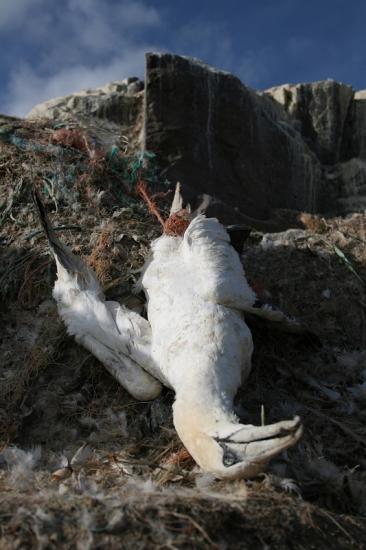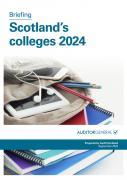Report highlights threat of marine plastics to seabirds
20th September 2017

A new report has highlighted the threat marine plastic pollution poses to seabirds in the northeastern Atlantic region. Researchers found that, of 34 seabird species investigated, 74% have ingested plastic.
The paper, published in the journal Environmental Pollution, was written by scientists at North Highland College UHI's Environmental Research Institute, part of the University of the Highland and Islands, and the RSPB Centre for Conservation Science. The authors collated data from all known studies reporting instances of plastic ingestion and nest incorporation in seabirds around northern Europe, Scandinavia, Russia, Greenland, Svalbard, the Faroes and Iceland.
Dr Nina O'Hanlon, a seabird ecologist at the Thurso-based Environmental Research Institute, was one of the scientists who worked on the project. She explains: "Marine plastic pollution is an increasing and global environmental issue which poses a major threat to marine biodiversity. The production of plastic continues to rise with millions of tons entering the oceans each year. Seabirds can ingest plastic, become entangled in it or incorporate it into their nests, causing impacts which may have negative consequences on reproduction and survival."
Dr Alex Bond, RSPB senior conservation scientist, said: "The northeastern Atlantic Ocean is home to internationally important breeding populations of seabirds and an amazing array of other marine life. Solutions to plastic pollution in the oceans require concerted action at its source on land - 80% of marine litter is thought to come from land - especially by producers and users.
"The properties which make plastics desirable are the very things which make it problematic," Dr Bond continues. "Due to its low cost, approximately half of all plastic items are produced for single-use. Plastic never breaks down, it only breaks up, into smaller fragments which remain in the environment and, as its density varies, it can be found throughout the water column, increasing the number of species which come into contact with it."
While the team's research highlights some concerning statistics, its report concludes that more coordinated, comprehensive and detailed investigations are required on plastic ingestion and nest incorporation to assess the full impact marine plastic is having on seabird populations.
Dr O'Hanlon explains: “In the northeastern Atlantic Ocean, an area of international importance for seabirds, there has been little effort to better understand how marine plastic affects different seabird species over time and regionally. We actually know very little about the current prevalence of plastic ingestion and nest incorporation for many species, several, like the Long-tailed Duck and Atlantic Puffin, which are globally threatened. Only 49% of the 69 species which are commonly found in the region have been investigated for plastic ingestion. We believe it’s vital to have a multi-jurisdictional, coordinated and collaborative effort to gain a more comprehensive and current understanding of this important issue."
The group’s research was undertaken as part of Circular Ocean, a project funded by the EU’s Northern Periphery and Arctic Programme, which aims to incentivise the reuse and recycling of marine plastic litter in remote and rural regions.
PHOTO
Northern Gannet supplied by RSPB Cymru
Related Businesses
Related Articles
Have your say in Thurso's future £100million investment by attending public consultation events
Thurso is to benefit from £100m investment in education and community facilities and are rolling out the first phase of public consultations on 9 and 10 December 2025. The Highland Council is inviting people that live, work, or study in Thurso, to come along to the public consultation events to have their say; this is an opportunity to help shape the future of Thurso, to gather views and ideas.Workforce North event spotlights Highland economy
EMPLOYERS and educators from across the Highlands have gathered to hear how a new initiative is aiming to transform the region's economy. Workforce North - A Call to Action brought together business leaders and teachers from primary and secondary schools from across the Highland Council area with a wide range of partners geared towards education, learning and skills development at Strathpeffer Pavillion.
Tartan challenge for UHI students offers £1,500 prize
Students from across the University of the Highlands and Islands (UHI) partnership have been challenged to design a tartan and be in with a chance of winning a £1,500 cash prize. Highlands and Islands Enterprise (HIE) has launched THE COMPETITION to mark 60 years since the regional development agency (then named Highlands and Islands Development Board) was established in November 1965.
University (UHI) Staff Strike in Dispute Over Job Cuts Today - 10 Redundancy Notices already Handed Out
Staff at University of the Highlands and Islands (UHI) have commenced a series of strike actions beginning 30 October 2025, in protest at proposed job cuts and the use of compulsory redundancies. The walk-out is set for four days this month today 30 October and further dates on 5, 17 and 18 November.Scotland's Colleges Feeling Impact Of Funding Cuts
Scotland's colleges face changing how they operate due to ongoing financial pressures. The sector has experienced a 20 per cent real terms cut in funding over the last five years.
Financial Health Report - Scottish Universities and Colleges
Scottish universities and colleges are navigating a sustained decline in public funding, significant cost pressures, and rising operating deficits. Universities saw their collective underlying surplus tumble by 92% in 2023-24, while colleges face a real-terms funding cut of 17% since 2021-22.
Scottish Colleges' Financial Challenges Increase
Scotland's colleges need more clarity from ministers on what parts of their role to prioritise, as the sector's financial challenges mount. Scottish Government funding for colleges reduced by £32.7 million in cash terms in 2024/25.
UHI and SQA announce new pathways for learners with articulation agreement 
The University of the Highlands and Islands (UHI) and Scottish Qualifications Authority (SQA) have announced the signing of a new articulation agreement. Yjis will allow learners who have completed SQA's Higher National Certificates and Diplomas to seamlessly progress onto UHI degree programmes at advanced levels increasing accessibility to higher education and streamlining progression pathways.
Highland And Islands MSP Rhoda Grant Refused A Meeting With Ministers As College Budgets In Scotland To Be Slashed
Highland and Islands MSP Rhoda Grant has hit out at a lack of engagement by the Scottish Government over planned cuts to UHI. Despite consistent requests for engagement and discussion with Scottish Ministers, there has been no commitment on holding talks.Research Partnership Established Between UHI Scientists And Bangalore North University In India To Support Groundbreaking Water Recycling Project
University of the Highlands and Islands (UHI) researchers from the Environmental Research Institute (ERI) based at UHI North, West and Hebrides Thurso campus, and the Centre for Living Sustainability based at UHI Inverness, recently returned from a visit to Bangalore North University in India where they established an environmental and social sciences research partnership. Dr.
